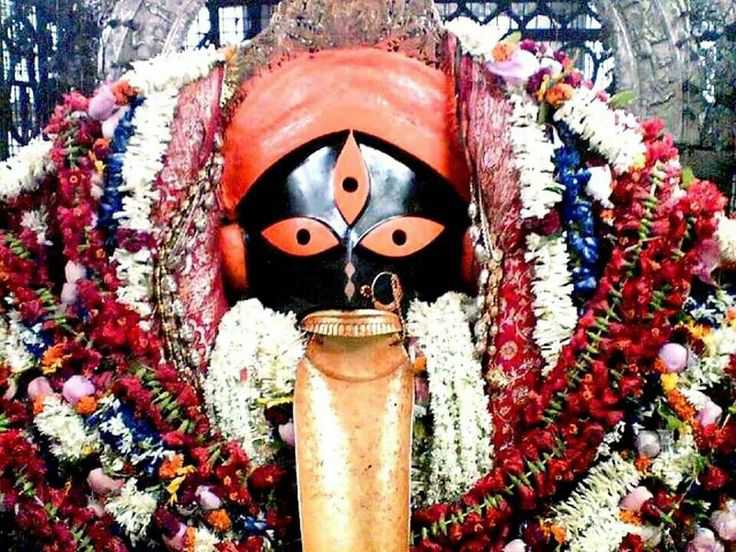Kalighat Temple is a historic and spiritual landmark in Kolkata, West Bengal. As one of the 51 Shakti Peethas in India, Kalighat Temple draws thousands of pilgrims daily who come to worship, seek blessings, or simply experience the intense devotion that permeates its walls. Dedicated to Goddess Kali, the temple is one of Kolkata’s oldest and most revered religious sites. This guide will take you through every detail you need to plan a fulfilling visit to Kalighat Temple.
Location
Located in South Kolkata, near the Adi Ganga canal (a former branch of the Hooghly River), Kalighat Temple lies in one of Kolkata’s busiest areas and hence also the most crowded. The temple’s proximity to popular city areas like Tollygunge and Rashbehari Avenue makes it easily accessible, and it is well-connected by public transport. The surrounding area is vibrant and bustling, with plenty of shops, food stalls, and vendors selling religious offerings and souvenirs for temple-goers. In fact Kalighat is actually home to the currently serving CM of West Bengal.
If you are looking for a trip to Kolkata do check out this page or you could just check hotels here. Here is the link to some credit cards that will give you exclusive deals on travel. This will help me earn a commission to keep this site up & running at absolutely no cost to you.
How to Reach Kalighat Temple
Reaching Kalighat Temple is quite convenient, as it is located in the heart of Kolkata and is well-served by multiple transportation options:
- By Metro: The nearest metro station is Kalighat Metro Station, located on the North-South Line (Line 1) of the Kolkata Metro, and is approximately 600 meters from the temple. The Jatin Das Park Metro Station, also on the North-South line, is nearby and offers another convenient option.
- By Bus: Kolkata’s extensive bus network makes it easy to reach Kalighat Temple. Buses from various parts of Kolkata stop near Kalighat or nearby Rashbehari Avenue, from where the temple is a short walk away. Buses from Howrah, Esplanade, and Salt Lake frequently pass through this area, providing ample options for public transport.
- By Taxi/Auto-Rickshaw: Taxis and auto-rickshaws are readily available throughout Kolkata and provide a comfortable way to reach Kalighat, especially if you are unfamiliar with Kolkata’s public transit system. Ride-hailing services like Ola and Uber are also popular and convenient for those visiting from further away.
Which Part of Sati Fell in Kalighat
Kalighat Temple holds immense significance as one of the 51 Shakti Peethas, sites where parts of the goddess Sati’s body are believed to have fallen. As per Hindu mythology, the right toe of Sati fell at this location, sanctifying the spot as a site of divine feminine energy. Kalighat’s association with Goddess Kali, the fierce manifestation of Shakti, has made it one of the most powerful and revered places for worship in India.
Many devotees believe that visiting Kalighat Temple and offering prayers here can cleanse sins and provide relief from life’s troubles. It’s also a place of penance and surrender, where worshippers come to seek the goddess’s protection and strength.

Temple Timings and Best Time to Visit
Kalighat Temple is open all week, with its busiest times generally being on weekends and during festivals. The temple’s hours are as follows:
- Morning: 5:00 AM – 2:00 PM
- Evening: 5:00 PM – 10:30 PM
Between 2 PM and 5 PM the temple gates close for the deity’s rituals and bhog (food for Goddess) offerings.
If you’re interested in participating in the temple’s rituals, the morning hours (5:00 AM – 8:00 AM) and early evening hours (around 5:00 PM) are the best times to visit. Aarti (worship ritual) is held multiple times throughout the day, with major aarti ceremonies in the morning and evening, offering visitors an opportunity to witness traditional rituals up close.
The Rituals at Kalighat Temple
Once inside the Kalighat Temple you will feel the reverence & fervor with which daily worship services, with several aarti and bhog (food offerings) rituals are performed throughout the day. Pilgrims flock here to receive Goddess Kali’s blessings, offer flowers, and perform puja. Standing in front of the deity, with the sounds of conches & clanging of cymbals renders an ethereal appeal to the atmosphere and can also give you goosebumps.
A notable ritual at Kalighat is the ‘Bali’ or sacrificial offering performed in traditional Hindu style. In the past, animal sacrifices were common, but these days, the offerings typically include symbolic offerings like coconuts. Pilgrims often offer these as a mark of surrender to the goddess, who is worshiped as a symbol of feminine power and divine protection.
A unique aspect of Kalighat is the prasad distribution, where food offerings are made to the goddess and then shared among devotees. The prasad, which usually includes sweets like sandesh and fruits, can be bought from the temple and trust me its extremely delicious as well.
Type of Rush and Rush Hours
Kalighat Temple is always bustling with devotees, but certain times see particularly high footfall. Here’s an overview of when you can expect different levels of crowds. Do note however that even with the least crowds it will take you at least 3 hours to complete the visit.
- Weekdays: Weekdays generally see a steady crowd, particularly in the mornings (5:00 AM – 8:00 AM) when worshippers come for darshan and prayers. Afternoons tend to be quieter, while evening aarti around 5:00 PM attracts another wave of devotees.
- Weekends: Crowds increase significantly on weekends, with large numbers of locals and tourists alike flocking to the temple. If you plan to visit on a weekend, it’s best to arrive early in the morning or later in the evening to avoid peak hours.
- Festivals: Major Hindu festivals, particularly Kali Puja (around Diwali) and Navratri, draw immense crowds, with lines stretching far outside the temple complex. During these times, the atmosphere is particularly charged with devotion, but the long queues may require patience.
Entry Fee and VIP Darshan Cost
Kalighat Temple has free entry, and pilgrims can enter and participate at no charge. However, those looking to avoid the long queues can opt for a VIP Darshan pass, available at the counter near the main entrance. The VIP entry costs around ₹150 per person, allowing you to skip the regular queue and have a closer view of the deity.
Architecture of Kalighat Temple
The architecture of Kalighat Temple is very unique, reflecting a mix of traditional Bengali temple architecture and distinctive design elements that set it apart from other temples:
- Nava-Ratna Style: The temple is designed in the traditional “Nava-ratna” style. There is a single spire or tower rising above the main shrine. The temple has a rectangular, pyramidal structure, with nine smaller spires around a central dome that rises from the main sanctum.
- Idol of Goddess Kali: The idol of Goddess Kali here is distinct and powerful. It is carved from black stone, with her eyes large and almond-shaped, embodying the fierceness of the goddess. The deity is adorned with gold ornaments, and her long, protruding gold-plated tongue is one of the idol’s most striking features, symbolizing both her ferocity and her hunger for evil’s destruction.
- Silver and Gold Embellishments: Inside the sanctum, intricate silver and gold embellishments adorn the walls and pillars, offering a royal setting to the goddess. The temple’s main altar is also made of silver, with elaborate designs typical of Bengali craftsmanship.
Are mobiles allowed inside Kalighat Temple?
Yes mobiles and bags are allowed inside. But given the kind of rush, be extremely careful of your belongings and also do not expect many opportunities to click photos. The photos will almost always be inundated with people.
Things to Explore for Visitors and Pilgrims
- Kundupukur (Sacred Tank): Within the temple complex is a sacred tank called Kundupukur, where pilgrims often perform rituals and purify themselves with a symbolic dip. The tank is considered sacred, and its water is used in the temple’s daily rituals.
- Kalighat Market: Surrounding the temple is a bustling market where you’ll find vendors selling everything from flowers, sweets, and incense to souvenirs, religious items, and local handicrafts. This vibrant marketplace is a great place to pick up traditional Bengali items and sample local street foods like jhal muri and phuchka.
- Pandas and Ritual Assistance: Numerous pandas throng the temple and who force you to take their services. Please be wary of them. Even if you choose to take their services, please ensure you agree on a donation amount beforehand, and the service being done. While many of these priests are genuine, it’s advisable to avoid those approaching outside the temple grounds.
Travel Tips for Visiting Kalighat Temple
- Arrive Early: To make the most of your visit, try to arrive early in the morning to experience the temple at a quieter time. This is especially advisable on weekends and during festival seasons.
- Dress Modestly: Given the temple’s cultural and religious significance, it’s respectful to dress modestly. Both men and women should ideally cover their legs and shoulders. You can check out traditional wear for women and traditional wear for men.
- Beware of Unauthorized Agents: There are several agents outside the temple who may offer “special darshan” services or rituals. Stick to the official temple counters if you want a VIP entry ticket or any specific service.
- Respect Photography Restrictions: Photography is strictly prohibited inside the main temple, particularly near the sanctum. It’s best to follow these rules to maintain the sanctity of the premises.
- Take Care of Belongings: As Kalighat is in a crowded area, pickpocketing can be a concern. Keep your valuables secure, and avoid carrying too much cash or unnecessary items.
Conclusion
A visit to Kalighat Temple offers an immersive experience, along with its unique architecture, the fierce beauty of Goddess Kali’s idol, and the temple’s historical significance, Kalighat Temple is a place of profound spiritual depth and cultural richness.
My Other Posts
If you are looking for options in Kashmir, check out my posts on Pahalgam, Gulmarg, Snowfall in Kashmir, and Best Time to Visit Kashmir. If you are looking for options in Ladakh, check out Ladakh Weather, Nubra Valley, 5 Days Kashmir Itinerary, Best Packing tips for Ladakh & best tourist places in Ladakh.
If you are looking for something in Sikkim, check Tsomgo Lake and Batasia Loop. If you are looking for some jungle safari read Gir Safari, or Bandipur Safari, feel blessed at Sri Venugopala Swamy Temple in Mysore.
If you are looking for places to visit in the Andaman Islands, please check my posts on Radhanagar Beach & Ross Island.
If you are looking for other options, check my posts on Murud Janjira, Kashid, Pirwadi Beach and Kihim Beach in Maharashtra or Malshej Ghat, Matheran Resorts, Kailash Temple Ellora, Vandri Lake, Kelwa Beach in Palghar & Mahabaleshwar.
Alternatively, if you are interested in some Religious tourism, please check my posts on Golden Temple, Kamakhya, Trimbakeshwar, Somnath Temple and Kashi Vishwanath. If you are looking for North East Adventure tours, check my posts on Shillong, Meghalaya, Dawki, Double Decker Living Root Trek, and 7-Day North East Itinerary.
For some adventure tours in the south check out Mandalpatti Trek, Discovering 10 Coorg Tourist Places, Coorg Weather & Best Time and Madikeri Fort.
If you are looking for some spirituality, you can check out Ganga Aarti in Dashashwamedh Ghat or Ghats in Varanasi.


3 thoughts on “Kalighat Temple – A Traveler’s Tale of Faith”